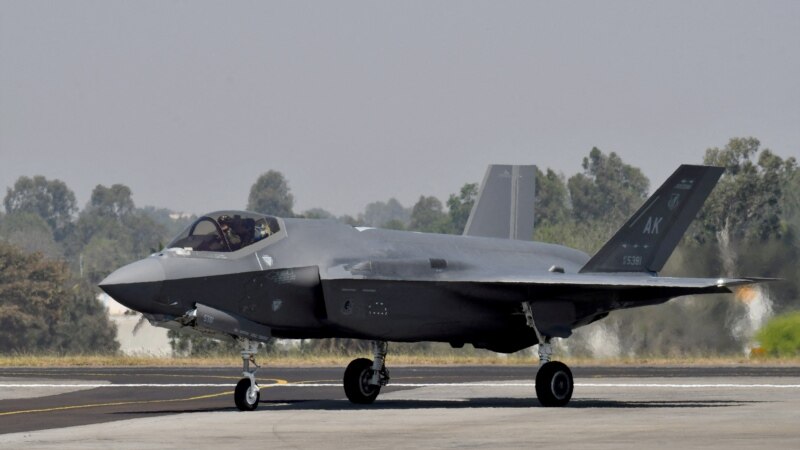US plan to boost Pacific air power seen as counterbalance to China

washington — A U.S. plan to boost its Pacific air power is seen by analysts as an effort to reinforce deterrence in the Indo-Pacific and counterbalance China's attempt to gain dominance in the region.
The U.S. Air Force plans to upgrade more than 80 fighter jets stationed at Japanese bases over the next several years as part of a $10 billion program to modernize its forces there.
The Defense Department announced the plan last week, saying it aims to enhance the U.S.-Japan alliance and bolster deterrence in the Indo-Pacific.
"This is a necessary upgrade that has been planned for some time. And combined with Japan's own investments, it will help maintain some degree of air power balance between the allies and China's progress in air force modernization," said James Schoff, senior director of the U.S.-Japan NEXT Alliance Initiative at the Sasakawa Peace Foundation USA.
"Without it, the credibility of U.S. deterrent capacity would be much weaker, which could cause Beijing to doubt U.S. seriousness about protecting the status quo across the Taiwan Strait and prompt more aggressive Chinese behavior," Schoff said.
The Taiwanese Defense Ministry said it spotted 37 Chinese aircraft near Taiwan on Wednesday as they headed to the Western Pacific for drills with the Shandong aircraft carrier.
Chinese jets and warships have frequently made dangerous maneuvers around the self-ruled island of Taiwan, which Beijing claims as a part of its own territory.
Former U.S. Indo-Pacific Commander John Aquilino told the Senate Armed Services Committee in March that China could soon have the world's largest air force.
China is currently the third-largest air power in the world, behind the United States and Russia.
China's rapid military modernization efforts have led it to possess more than 3,150 aircraft, of which about 2,400 are combat aircraft, including fighters, strategic and tactical bombers, and attack aircraft, according to the Pentagon's 2023 report on China's military power.
Liu Pengyu, a spokesperson for the Chinese Embassy in Washington, told VOA on Monday that "U.S.-Japan relations should not target or harm other countries' interests and should not undermine regional peace and stability."
Upgrade designed to help defend Japan
In addition to protecting Taiwan, the upgrade — which includes the advanced F-35 jets — also will help U.S. Forces Japan (USFJ) deter North Korea and defend Japan's Southwest Islands, said James Przystup, a senior fellow at the Hudson Institute.
Japan has a territorial dispute with China over what it calls the Senkaku Islands and what China calls the Diaoyu Islands.
Japan and Russia also have a dispute over islands off Hokkaido, which Japan calls the Northern Territories and Russia calls the Kuril Islands.
The U.S. aircraft upgrade plan is to modify several deployed F-35B jets stationed at the Marine Corps Air Station Iwakuni in Yamaguchi prefecture south of Hiroshima.
The Misawa Air Base in Japan's northern Aomori prefecture will see 36 F-16 aircraft be replaced with 48 F-35A jets.
Aircraft will be rotated
At Kadena Air Base in Japan's southern island of Okinawa, 48 F-15 C/D jets will be replaced with 36 new F-15EX jets. During the upgrades, fourth- and fifth-generation tactical aircraft will be dispatched on a rotational basis, according to the Pentagon.
"The upgrades will provide qualitative and quantitative boosts to the USFJ inventory, which will also enhance the U.S.-Japan alliance's readiness against China, North Korea and Russia," said Ryo Hinata-Yamaguchi, a professor at the University of Tokyo and a nonresident senior fellow at the Atlantic Council's Indo-Pacific Security Initiative.
"Benefits will be seen not only in aerial operations but also guarding U.S. and Japanese capabilities for naval and amphibious operations. The platforms are not simply about technological superiority for combat, but also more advanced electronic warfare capabilities to penetrate weaknesses of China, North Korea and Russia," he said.
China often conducts joint air drills with Russia over the waters near South Korea and Japan. In December, Chinese and Russian jets entered South Korea's Air Defense Identification Zone, prompting Seoul to scramble fighter jets in response.
David Maxwell, vice president of the Center for Asia Pacific Strategy, said, "Russia has been conducting some combined operations with China on a limited basis recently, so if Russia operates in the Indo-Pacific, it will certainly indicate these systems will contribute to the defense of U.S.-allies' interests."
Maxwell said U.S. bases in Japan give the U.S. "a lot of operational flexibility to be able to deal with multiple contingencies, either on the Korean Peninsula or in the South China Sea, or really, anywhere in Asia."
Okinawa is about 740 kilometers (459.8 miles) from Taiwan and 990 kilometers (615.1 miles) from South Korea's southern port city of Busan. Kadena, which the U.S. calls "the keystone of the Pacific," is the largest U.S. installation in the Indo-Pacific.
Zack Cooper, senior fellow at the American Enterprise Institute, who served as special assistant to the principal deputy undersecretary of defense for policy during the George W. Bush administration, said rotating aircraft presence at Kadena during the upgrade transition helps the U.S. disperse them in case of an attack.
"Kadena Air Base is under greater threat than it's been in decades," from a range of Chinese capabilities, both ballistic and cruise missiles, he said. "There are a couple of options for how to deal with that. One is for the U.S. to disperse its forces more so that if there was an attack, there would be less concentration of U.S. forces."
